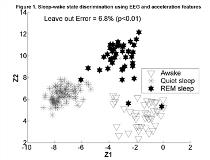SLEEP-WAKE STAGE AND BEHAVIOR DISCRIMINATION IN RATS USING A COMBINATION OF EEG AND HEAD ACCELERATION MEASUREMENTS
Abstract number :
3.081
Submission category :
Year :
2005
Submission ID :
5887
Source :
www.aesnet.org
Presentation date :
12/3/2005 12:00:00 AM
Published date :
Dec 2, 2005, 06:00 AM
Authors :
1,2Sridhar Sunderam, 1,2Nathalia Peixoto, 1,2Nick Chernyy, 1,2Jonathan P. Mason, 4Steven L. Weinstein, 1,3Steven J. Schiff, and 1,2Bruce J. Gluckman
Accurate brain state discrimination and the ability to identify both normal and abnormal state and state transitions is critical for development of continuous feedback algorithms for control of seizures. Prior methods for states of vigilance discrimination used EEG spectral measures alone. Here, we show that head acceleration measured using biaxial microelectromechanical systems (MEMS) accelerometers significantly enhances sleep-wake staging in rats implanted with bilateral hippocampal depth and cortical EEG electrodes. Rats were video and EEG monitored continuously for 7 days and digital recordings made of the EEG and acceleration signals acquired using custom made electronics which included DC sensitive accelerometers in the headstage. An EEG expert inspected video and EEG to classify sequential 15 s epochs of representative 1 hour recordings into different sleep-wake stages: Awake, Quiet Sleep and REM Sleep. Observed awake behavior was also labeled and divided into three categories: Exploration/Repositioning, Eating/Drinking/Grooming and Quiet/Twitching. Total power (dB) in four frequency bands (0.5-3.9, 4.0-7.9, 8-12.9, 13.1-50 Hz) was measured in 1 sec windows of the EEG (2 cortical, 2 depth) and head acceleration (x and y axes) and averaged over each 15 s epoch. The data was divided into two equal halves, a training set and a test set, and the 24 features were used to perform a linear discriminant analysis of the training set. The leave-one-out classification error for sleep-wake stages was 9% (p[lt]0.01) using only EEG features, and improved to 6.8% (p[lt]0.01) when acceleration features were included (Figure 1). Similar performance was obtained for the behavioral state classification. Applying the linear classifier to the test data set gave significant agreement (p[lt]0.01) of over 90% for sleep-wake and behavior classification. Head acceleration measurements with EEG not only significantly improved the ability to discriminate broad transitions between REM sleep, quiet sleep and waking, but also distinguish patterns highly distinctive of behavior such as grooming, twitching or feeding. This capability will be especially useful in automatically detecting and selectively treating seizures using feedback control.[figure1] (Supported by NIH Grants R01EB001507, K02MH01493, and R01MH50006.)
